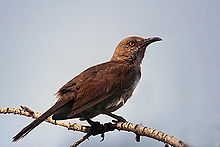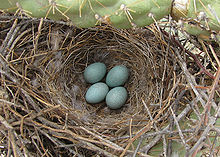- Curve-billed Thrasher
-
Curve-billed Thrasher 
Conservation status Scientific classification Kingdom: Animalia Phylum: Chordata Class: Aves Order: Passeriformes Family: Mimidae Genus: Toxostoma Species: T. curvirostre Binomial name Toxostoma curvirostre
(Swainson, 1827)The Curve-billed Thrasher (Toxostoma curvirostre) is a perching bird of the thrasher group native to the southwestern United States and much of Mexico.
The Curve-billed Thrasher is generally 25 to 28 cm (10 to 12 inches) long, slender in build with a long tail, and a long, curved, sickle-shaped bill. It is pale grayish-brown above with lighter-colored underparts that are vaguely streaked. The tips of the tail are streaked with white, and the sides of the tail are a darker color than its back. The eye of an adult is usually a vivid orange or red-orange, although immature birds have a yellow eye.
Because of its similar coloration to Bendire's Thrasher, the two birds are easily mistaken for one another. Bendire's Thrasher's shorter and straighter bill and yellow eyes distinguish it from mature Curve-billed Thrashers. However, it is still easy to misidentify a young Curve-billed Thrasher as a Bendire's Thrasher as its beak has not grown to its mature length and curvature, and its eyes are still yellow. Aside from Bendire's Thrasher, the Curve-billed Thrasher can be easily distinguished from other thrasher species in its range as it has a streaked breast, unlike the others' plain breasts.
The Curve-billed Thrasher is commonly found throughout the deserts and brush-filled areas of the south-western United States, from about the Sonoran Desert of Arizona and across New Mexico to west Texas, as well as most of Mexico, from the Sonoran-Chihuahuan Deserts and south through the Mexican Plateau to regions south of the Trans-Mexican Volcanic Belt in south-central Mexico.
The Curve-billed Thrasher often roosts in a tall tree or spiny vegetation, preferring a cactus. The nest is a loosely woven cup made of thorny twigs. The female lays 2 to 4 eggs, which are bluish-green and speckled with brown. The eggs are incubated by both sexes, and hatch after about thirteen days. The young will leave the nest after 14 to 18 days after hatching.
The Curve-billed Thrasher feeds on ground-dwelling insects, as well as seeds, and berries. It often pushes out Cactus Wrens in its area. This thrasher's voice is a sharp, liquid, whistle wit-WEET!, or wit-WEET-wit, as well as a warbling, squeaky, hurried song.
References
- BirdLife International (2004). Toxostoma curvirostre. 2006. IUCN Red List of Threatened Species. IUCN 2006. www.iucnredlist.org. Retrieved on 12 May 2006. Database entry includes justification for why this species is of least concern
- "Toxostoma curvirostre". Integrated Taxonomic Information System. http://www.itis.gov/servlet/SingleRpt/SingleRpt?search_topic=TSN&search_value=178637. Retrieved 9 February 2006.
External links
- Curve-billed Thrasher Species Account - Cornell Lab of Ornithology
- Curve-billed Thrasher - Toxostoma curvirostre - USGS Patuxent Bird Identification InfoCenter
- Curve-billed Thrasher Information and Photos - South Dakota Birds and Birding
- Curve-billed Thrasher photo gallery VIREO
Categories:- IUCN Red List least concern species
- Mimidae
- Thrashers
- Toxostoma
- Endemic birds of Southwestern North America
- Birds of Mexico
- Fauna of the Chihuahuan Desert
- Fauna of the Sonoran Desert
- Birds of the U.S. Rio Grande Valleys
- Native birds of the Southwestern United States
- Birds of the United States
Wikimedia Foundation. 2010.


